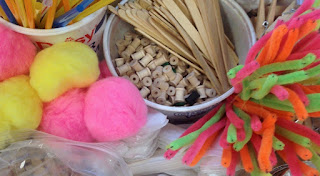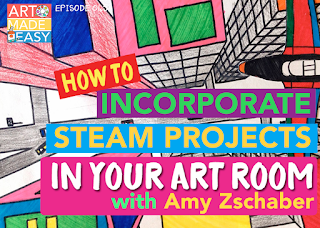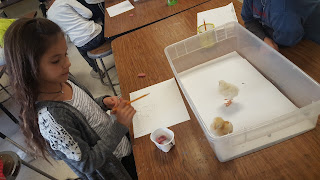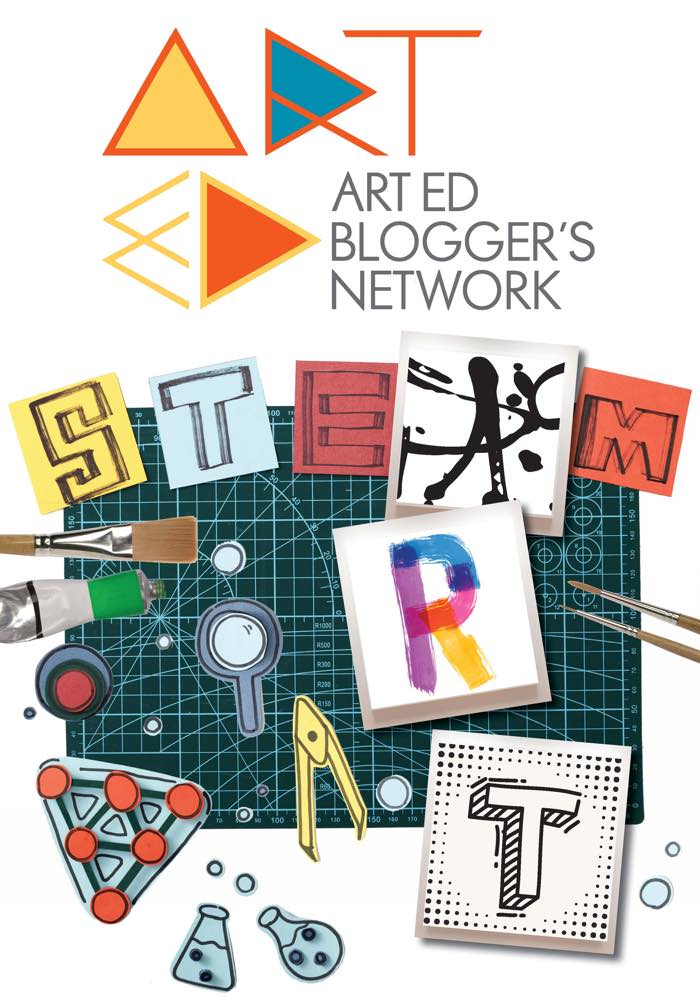(Image provided by Sciencecosmos.com)
For my Spring break, I'm investigating on how to build a stronger foundation for the "A" in "STEAM" for my school district. For the past few years, I've researched how art teachers have already integrated core subjects within our curriculum. With the rise of STEM learning and the explosion of makerspaces, I want to jump on that bandwagon and assist in supporting the STEAM approach. After presenting for Education Closet's STEAM conference back in 2014, writing for Arts & Activities and multiple blog posts, I'm more than ready to join my school and assist in designing our own makerspace!
But first, let's visit the main question...
In the article written in Education Week, the author explains that, "children who study STEM develop a variety of skills that are essential for success: critical thinking and problem solving, creativity and innovation, communication, collaboration, and entrepreneurship, to name a few."
But in recent years, the idea of adding arts to STEM has been drawing attention. The argument between both sides of the story is this (shared from the article):
From arts proponents: Engineering and technology can certainly serve the artist and help create art. But if we're talking about how one can use art in engineering… as an artist, it seems we're missing the point and devaluing, or not realizing, art’s purpose and importance. We have it backwards.
The article further explains how we can include STEAM elements within our lessons such as design, performing arts, and creative planning.
When I began learning about the STEAM approach a few years back, I met Susan Riley from Education Closet, plus followed a few conferences offered through the site, which are offered in Winter and Summer each year.
As a strong advocate for the STEAM approach, Education Closet explains that, "STEAM is a way to take the benefits of STEM and complete the package by integrating these principles in and through the arts. STEAM takes STEM to the next level: it allows students to connect their learning in these critical areas together with arts practices, elements, design principles, and standards to provide the whole pallet of learning at their disposal. STEAM removes limitations and replaces them with wonder, critique, inquiry, and innovation."
Education Closet further explains that in order to STEAM with integrity, schools must consider a variety of factors, including:
1. Collaborative planning, including a cross-section of teachers on each team
2. Adjusting scheduling to accommodate a new way of teaching and learning
3. Professional development for all staff in STEAM practices and principles
4. STEAM-mapping for the curriculum design process
5. Alignment and unpacking of standards and assessments
6. Seamless lesson implementation processes and strategies
---------------------------------------------------------------------------------------------------------
Time to Research!
With that said, I then began to investigate how to emphasize STEAM projects within my art curriculum. I've included below many of the podcasts and websites I used in research for this purpose. I love many of the sites and resources I've provided, and I hope they help you in your research as well.
----------------------------------------------------------------------------------------------------------
Artful Practice for Young Makers
One of the biggest take-aways from listening to this podcast was how to create a self-serve area that is age appropriate for kids. In having centers for Kindergarten through 6th grade, we need to know what materials are appropriate for each grade level and allow those students to explore those materials. Rachel created what's called an "invitation table" for young students to explore materials available without a teacher guiding a curriculum driven-lesson.
Now, my biggest struggle as an over-organized, type A art teacher is allowing the mess to flow. Yes, students should be responsible for cleaning up their own messes, but it is recommended to allow the student to explore their own creativity with materials available. According to Rachelle Doorley, messes come with the territory, but if you don't provide the resources, you're limiting the students from the creative process. As a teacher, we need to guide the students in learning responsibility with cleaning up the messes. We already do it in our classrooms with projects, but continue to encourage responsibility for the makerspace.
Also, another big struggle is allowing students to give up and restart when they do not "feel" the project anymore. Since my projects follow a curriculum with a time frame, it's a challenge with students who wish to restart within that time frame. Basically, I do not feel I can allow a student to restart right before a due-date, however, if they change their minds in the beginning stages, the student can easily catch up to meet the time frame.
There's also a few good resources listed in the above link! One of my favorites in the "Ten Tinkerlab Habits of Mind," (download available in above link)
---------------------------------------------------------------------------------------------------------------
Extending the Art Room: Starting a Makerspace
While reading this article, there was a paragraph that caught my attention that made perfect sense, especially since we're always caught up on having the new-and-improved technology:
"As the “maker movement” gains momentum, makerspaces seem to incorporate more and more technology-based tools and materials. 3D printers, Spheros, and Snap Circuits are currently popular but can be spendy choices when servicing a large number of students. The beauty of the “maker movement” is that it doesn’t have to be an expensive mission for your school or department to take on. Tactile activities are just as important as the tech options, and diversity in your makerspace materials leads to more authentic tinkering and exploration." -Tracy Hare
The article provided a good beginner list in collecting materials for a successful makerspace. Luckily, my school had already begun designing a room to store materials that were already in the list, and we add more to it every day!
Sometimes, we need a reminder that kids do not need everything right away to have the perfect makerspace. We can start small, and make our way to bigger things.
----------------------------------------------------------------------------------------------------------
Incorporating STEAM Projects in the Art Room
For this podcast, Ana Dzingle explains not only how to incorporate more STEAM in the art room, but how to we can still be artistic while using non-traditional materials.
Ana tells us that everybody is creative, we just need to find the medium that works best with each of us. I find this to ring true because of what I see in my own art room. Not every students enjoys drawing or painting, but they thrive with other areas, such as printmaking, coding, or sculpture.
STEAM projects are great problem-solving projects. They integrate multiple subjects, which helps students to make connections. Projects for younger students should also be explorative. Students are learning materials and processes, which helps them to learn what materials can do.
Ana also discussed how students pick up on how adults model artistic behaviors. When the teachers and parents get involved, the students are more engaged.
Ana's blog consists of lessons and projects for young students (Pre-K & up). You can view her blog here for ideas that you can use in your art classes!
Ana also co-authored the book STEAM Kids
----------------------------------------------------------------------------------------------------------
How to Incorporate STEAM Projects in the Art Room
In this podcast, Patty interviews Amy Zschaber, author of the blog "Artful Artsy Amy."
Amy explains the difference from an art project and a STEAM project is when we emphasize how science, technology, engineering, and mathematics is included within the process of the lesson. We may be doing STEAM projects without realizing it because we emphasize more of the artistic elements instead of the integrated ideas. For example, when designing artworks of cities, buildings, or perspective, mathematics and engineering are involved in the design.
Amy also discusses collaborating with colleagues to assist with designing STEAM projects in and out of the art room. It's about building a bridge between subjects.
-------------------------------------------------------------------------------------------------------
I've been in love with the videos created by OK GO for a few years now, and my absolute most favorite video is for the song, "This Too Shall Pass," which is a gigantic Rube Goldberg experiment. There is SO much involved with creating their videos, and to assist teachers with inspiring students, OK GO has provided this website to help break down the planning of their videos and how STEAM concepts were involved. I've been sharing their "Primary Colors" video with my young students, which is a stop-motion video sharing how primary colors are made.
Many of the resources provided in this site go over choreography, technology, testing, paper mapping, and shooting the videos. They also go over collaboration and refining their works, which teaches students how to fine-tune any project, song, performance, or written document they create.
--------------------------------------------------------------------------------------------------------------
Searching for Local Treasures
If a company like this is available in our local area, I wonder how many more amazing companies are available for you around the world!
-----------------------------------------------------------------------------------------------------------
Applying Team Challenges
In creating a makerspace with centers, it's a prime opportunity to incorporate team challenges. In this article, Amanda Koonlaba shares her insight on how she began using the idea of creative team challenges for teams to solve problems and collaborate.
Amanda researched why students normally struggle with working together and came to the conclusion that students didn't know how to make decision with other people and share materials. She continues to say that these types of social skills don't come naturally, and it is up to the teachers to help assist students in developing those skills.
Amanda then explains how coaching and time management helped students in developing skills in team-building and how students enjoyment sky-rocketed. After reading the article, I realized how much I needed to push for more collaboration in my art classes. It takes more than just sharing the materials available. It's planning and building together.
---------------------------------------------------------------------------------------------------------------
So What's Next?
Now that I've found plenty of sources, it's time to start planning! I already started contacting SpaceLab1, signed up for classes, and shared information with our administration! We have our supply storage STEAM room filled, and we'll be planning our makerspace soon!
Discussions have been started on co-teaching, which will help students learn how to design the makerspace themselves, teaching how to design floor plans!
As for my classroom, I want to work more on building team collaboration in my classroom. Taking time to research helps each of us understand what we can do to help our students for the future in the arts, and to have our students be successful future designers and creative thinkers.
---------------------------------------------------------------------------------------------------------------
Here's a resource to assist you in advocating for STEAM learning. You can sign up to be a part of the site and others where STEAM is happening and how it's making a difference!
---------------------------------------------------------------------------------------------------------------
I would like to give thanks to the people who supplied my research for my Passion Project PD and assistance in designing our school's future Makerspace:
The Art of Ed (Tracy Hare)
Deep Space Sparkle (Patty Palmer, Amy Zschaber, Ana Dzingle, Rachel Doorley)
Education Closet (Susan Riley, Amanda Koonlaba)
SpaceLab1
STEAMtoSTEAM.org
























